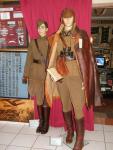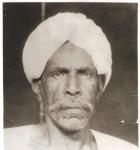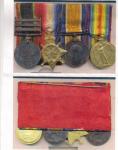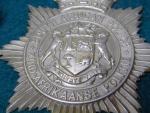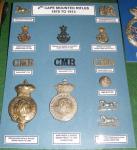
sabrigade
For Deletion-
Posts
1,707 -
Joined
-
Last visited
-
Days Won
34
Content Type
Profiles
Forums
Blogs
Gallery
Events
Store
Everything posted by sabrigade
-
Hi Paul, The first medal in the group is the Sudan Defence Force General Service Medal. It was awarded by the Commander of the Sudanese Defence Force to Sudanese members of the SDF. Police and other approved Sudanese personnel for service in the field. The approval was from the Governor General of the Sudan who had to confirm the importance of the specific operation/s. It was also awarded for service/action against Italian forces from June 1940 to November 1941. I am of the opinion that the latter reason confirms the award of the medal to my recipient. Instituted in November 1933, approximately 9000 were awarded. Regards, Will
-
MEDALS ARE MOUNTED AS WORN During the course of my work and travels in the Sudan, I met Khalid's grandson and family in Kassala in Eastern Sudan. After a long period of discussions and negotiations, the family decided that the medals should go to my collection and I was able to purchase them Kassala was the scene for a number of actions during the Second World War and was bombed and captured by the Italians on occassion. It is very difficult to obtain service records in the Sudan but through the family's memories I was able to piece the following together: Born in 1919 in Kassala, Khalid joined the SUDAN DEFENCE FORCE in 1939. He served in the Eastern Arab Corps and participated in various internal Sudanese operations and fought against the Italians. Khalid participated in the Second World War and saw action in Abyssinia, Libya and Egypt. He took part in the Battle of El Alamein. At the conclusion of the Second World War, he left the army and settled and lived in Kassala. Khalid died of natural causes in 1979.
-
Bronze BWM collection
sabrigade replied to Brian Wolfe's topic in Great Britain: Orders, Gallantry, Campaign Medals
An excellent article was written in the Journal of the South African Military History Society a few years back. Military History Journal - Vol 10 No 1 (incorporating Museum Review) SOLDIERS WITHOUT REWARD Africans in South Africa's Wars by J S Mohlamme On 17 July 1917, King George V, in a speech to the SANLC in Abbeville, called them 'part of my great Armies which are fighting for the liberty and freedom of my subjects of all races and creed throughout the Empire. '(5) "At the conclusion of hostilities, the African troops were returned to South Africa and disbanded. They were bitterly disappointed and resented the fact that despite their sacrifices they were awarded no medals or ribbons. To compound their misery, blacks from the High Commission Territories who had served in the same units were issued medals, as were blacks who had served in South West Africa with the South African Artillery and the South African Mounted Rifles (SAMR).(6)" HOPE THIS IS COPYRIGHT COMPLIANT? MY COMMENT! -
Bronze BWM collection
sabrigade replied to Brian Wolfe's topic in Great Britain: Orders, Gallantry, Campaign Medals
Thomas, That is correct, another one of those strange issues, some members received the MSM but no campaign medals! -
The "red cloth" indicated that the bearer had signed an oath or commitment to serve anywhere in Africa and had therefore volunteered his/her services for the various campaigns in which the South Africans took part during WW2. The oath was necessary due to the fact that the South African Defence Act of the time only allowed compulsory military service for South African citizens within the borders of South Africa. Signatories of the oath later became eligible for the Africa Service medal. It should be noted that the Oath was not signed by all members of the Union Defence Force
-
Bronze BWM collection
sabrigade replied to Brian Wolfe's topic in Great Britain: Orders, Gallantry, Campaign Medals
Only members of the S.A.N.L.C. from the British Protectorates such as Basutholand and Bechuanaland were issued with the bronze British War Medal. The black South African members were not issued with the medal and this appears to have been a political issue taken at the time. White European members, who formed the leader group, were entitled to the same medals as their white South African counterparts in other WW1 South African units. Strangely enough, trios were issued to non-white members, maily drivers, for service in German South West Africa and are rather scarce. I have a trio in my collection. As regards Mervyn's questions on numbers, according to the official history of South Africa and the Great War, the following returns are given: 292 officers, 1204 'European" warrant and non-commissioned officers and 25090 'Native" were members of the S.A.N.L.C. 27 of these soldiers died in the course of their duties. -
Snake buckle belt
sabrigade replied to Jef's topic in Great Britain: Militaria: Badges, Uniforms & Equipment
Hi Thomas, I hope to be back in South Africa next week and will make it a seperate thread. Regards, Will -
Hi Len, The QSA is a very popular medal for collectors. As pointed out in the previous posts, there are many ways to approach this collecting field. I personally have collected and completed all the various clasps and have a bronze example as well as the transport medal in my QSA frame. I know of collectors who collect various regiments or the different Town Guards and DMT. Gook luck! Regards, Will
-
Snake buckle belt
sabrigade replied to Jef's topic in Great Britain: Militaria: Badges, Uniforms & Equipment
Equipment used by South African forces in WW1 varied greatly and can be analysed according to the various campaigns and theaters. The Pattern 1903 Bandolier Equipment was used by South African Artillerymen in East Africa, Palestine and also by the South African batteries of the Royal Garrisson Artillery on the Western Front. Only the 50 round bandolier, water bottle and haversack were worn and used. Large numbers of german leather equiment had been captured during the German South West African Campaign and these sets were used mainly by the machine gun elements of the South African Mounted Riflemen in German East Africa. This equipment is better known as the "Schutztruppen" or Mounted equiment. Some sub-units in East Africa were issued with the Pattern 1908 Web Infantry Equipment but this was very limited ("A " Company of the 6th SAI). Most units used the 50 and 60 round bandoliers. The Battalions of the Cape Corps were issued with Pattern 1908 Web Infantry Equipment and they used the equipment in both German East Africa and Palestine. The South African Infantry regiments that fought on the Western Front were mainly issued with the Pattern 1914 Leather Infantry Equipment so they DID use and wear the "snake-buckle" belt. Some photographic evidence exists of individual memebrs of these regiments wearing the Pattern 1908 Web Infantry Equipment. I am fortunate to have complete sets or examples of these items in my collection. Regards, Will -
Hi Tony, I think it depends on the specific company that manufactured the badge. A friend of mine has a SWB in a totally different case. The badge itself has its own varients, I am the proud custodian of SA no 3 which looks completely different on the reverse to the other variants. A fascinating subject, still many "unknowns" out there! Regards, Will


